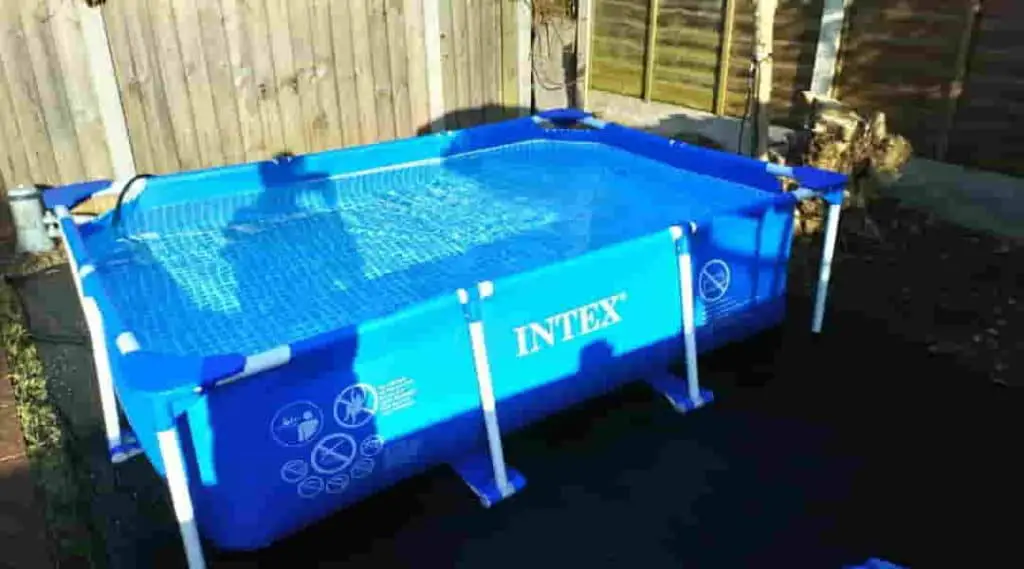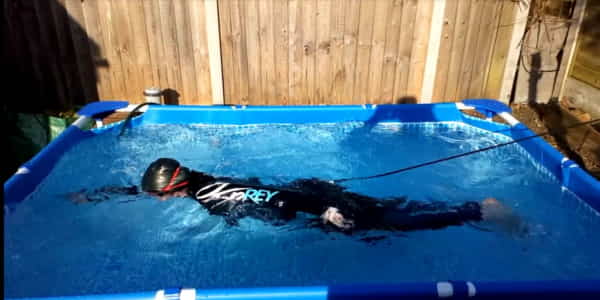Training in your above ground backyard pool is a great way to swim in your own time, avoid the crowds at the public swimming pool and get in some swim distance without ever leaving your home.
As a general rule, it is possible to train in an above-ground backyard pool using a swimming harness. The pool needs to be long enough to accommodate the height of the swimmer and deep enough to accommodate a freestyle swim stroke, which can be as shallow as 1 meter deep.

In this article, I will look at:
- How you can train in a small backyard pool
- Swimming laps in a backyard pool
- The size of pool you need to train in
- Work-out ideas for above-ground pools
How Do I Train My Backyard Pool?
The key to long-distance and training in your backyard pool, (also known as a garden pool or above ground pool), is to use a swimming harness.
A swim harness is an elasticated bungee cord with a harness that attaches to either your feet or your waist, that holds you in position while you swim.
Here is a picture of my swim harness in action, in my garden pool:

The swim harness acts as a resistance band, so you are swimming against the force of the bungee cord resistance.
This allows you to “statically” swim, or converts your backyard pool into an infinite pool as you can swim all day long, without going anywhere!
This is a wonderful method to swim freestyle in your small pool and has been used by pro swimmers and Olympic athletes, particularly during the 2020 Pandemic when nearly all public training pools were closed.
Here is an example of an Olympic swimming champion, Sharon van Rouwendaal, training in her above-ground backyard pool.
At first, swimming with a swimming harness (also called a swim tether, or swim cord), can feel strange, but it is amazing how quickly the body adapts.
Personally, I prefer a swimming harness that tethers to my waist. However, you can get swimming harnesses that tether your ankles.
Which you chose really comes down to personal preference, and I discuss swimming harnesses in a lot more depth in my dedicated article on the topic.
Can You Swim Laps In A Backyard Pool?
I love swimming laps and seeing how far I have swum each day. I always get an endorphin hit when I see my swimming distances increase.
It is possible to swim long distances, equivalent to pool laps, in a small backyard pool.
I discovered this from my Flex2 FitBit, which is worn on the wrist, is water-resistant and can track how far you have swum.
I wear my Fitbit in the pool while swimming and I enter how long the pool is into the Fitbit app, from this the Fitbit will give an estimate of how much distance I swim.
I did not believe that the FitBit would work in my backyard pool, where I am tethered while swimming, and give me a good estimate of how far I swam, but it did!
As I already know how far I can swim in 40 minutes in a 25-meter public pool, I know that the FitBit is giving me similar times for my session in the backyard pool, even while tethered! I have double-checked the accuracy of my Fitbit by later counting pool laps in my local public pool and seeing how close the actual measured FitBit results are.
I have found that the Fitbit is typically accurate to within 50meters, which is two standard pool lengths, so not perfect, but a good estimate and close enough for regular fitness swimmers to use.
In conclusion, you can swim laps in your backyard pool while tethered, as you can estimate using fitness trackers such as the FitBit range to record your times and distances.

If you want a more in-depth look at training times and creating a good workout, check out my article: How Long Do I Need To Swim To Get A Good Workout? Times & distances included.
What Is The Smallest Pool Size I Need To Swim In?
When buying my first backyard above-ground garden pool, my biggest concern was size. It needed to be long enough and deep enough to swim freestyle comfortably.
Typically, a minimum depth of 3 feet (0.9 meters) is preferred by most adult swimmers. The pool needs to be long enough to accommodate a swimmer stretched out fully, doing freestyle with at least an additional 2 feet of clearance to ensure the swimmer is not hitting the ends of the pool.
As a rule of thumb, the more room you can accommodate the better, so always go bigger if you can afford it. However, sometimes garden space does not allow it, so we have to consider the smallest pool size.
It is possible to swim in shallower water, however, you may find that the tips of your fingers touch the bottom of the pool.
When considering the length of the pool, the pool needs to be long enough to accommodate a swimmer, stretched out doing freestyle. Therefore, measure from the tips of your toes to the tips of your fingers, with your arms extended fully above your head.
Add some extra space for comfort or you’ll touch the sides of the pool. For a more detailed breakdown of working out the ideal depth of water for your own pool, take a look at my article, Minimum Water Depth for Swimming – How much water do you need?
Will Swimming In A Small Pool Damage My Swim Technique?
If you are using your small backyard pool to train in, there is a good chance that the quality of your swim stroke and swim technique matters to you.
After spending a year training in a small garden pool, just big enough to accommodate my size, I was concerned that my swim technique would be negatively affected.
In addition, my fingers touch the bottom of my backyard pool on the freestyle stroke, so I have slightly adapted my stoke which I was concerned about.
Finally, after a year, I got back into a large 25-meter public pool for a lane swim (The public pools were closed long term due to the Covid Pandemic).
I can confirm that a year of swimming in a small backyard pool did not negatively impact my swim technique or stroke.
In fact, I would say that my swim technique improved as I had the time and space in my backyard pool to work on my swim technique.
Above-Ground Pool Workout Ideas
1 – Kicking Workout
Practising swim kicks can be an amazing cardio workout
- Hold the side of the pool wall, or grab a kick board.
- Kick aggressively for 60 seconds.
- Stop and rest for 10 seconds (or until you get your breath back)
- Repeat x3 times
- Increase the kicking duration and shorten the rest periods as you get fitter and progress.
2 – Timed Sprints
When in an above-ground backyard pool, you may not have your smartwatch or Fitbit set up to measure your distance.
A good way to measure your workout and train is to do timed sprints.
- Set a watch or timer for 3 minutes.
- Swim freestyle continuously for the 3 minutes.
- Try to push your speed and intensity so you increase your heart rate.
Working against a clock can be a great motivator, but in addition, it can help you manage your energy so you know when to put in maximum effort and when to pull back.
I am a great believer and user of HIT (high-intensity training) after learning about the incredible benefits from short, high-intensity bursts of exercise from Dr Michael Mosley in his book, Fast Exercise: The simple secret of high-intensity training: get fitter, stronger and better toned in just a few minutes a day
This is an amazing way to train hard yet efficiently in your small backyard pool.
3 – Use Hand Paddles For Strength Training
Hand paddles are paddles that attach to your hands. This causes greater resistance with the water, allows you to swim faster and is a great strength workout as you are using more strength to pull through the water.

Using hand paddles as part of your workout in a small pool can be done as part of any swim stroke, or even standing up and just treading the water.
You will quickly feel your arms get tired as you will feel the extra resistance on your forearms.
- Attach the hand paddles to your hands.
- Gently pull through the water, either as part of a swim stroke or treading water.
- Complete a 3 minute swim set.
Hand paddles will quickly fatigue your arms and muscles, so like all weight and resistance training, be careful not to overdo it and cause an injury.
4 – Use Water Weight Dumbbells
Just being in the water is a workout because of the resistance the water provides.
If you want to increase your strength training or incorporate dedicated strength training as part of your swim workout, you could use water dumbbells.
If your pool is deep enough (waist or shoulder deep), or you can sit in the water, you could work with water dumbbells.

Here is a good instructional video on how to use water dumbbells in your above ground pool.
Final Thoughts
Using an above ground garden/backyard pool is a great way to swim train at home.
It is perfectly possible to maintain a good swim training workout in a small backyard pool.
Although it takes a bit of time to get used to swimming with a swimming harness, it is amazing how quickly we can adapt.
Training at home in your above ground pool has so many advantages, including fewer crowds and more space and time to improve and work on techniques.
Although here in the UK, in the winter months it can be very cold for outdoor swimming, I would still prefer to train in my garden at my pace and time than fighting for some free lane space at my local public pool.
If the temperature of the water is a concern for you, take a look at my article on heating your backyard pool:
